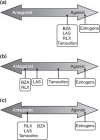The evolution of selective estrogen receptor modulators in osteoporosis therapy
- PMID: 22853318
- PMCID: PMC3793274
- DOI: 10.3109/13697137.2012.688079
The evolution of selective estrogen receptor modulators in osteoporosis therapy
Abstract
Selective estrogen receptor modulators (SERMs), which exhibit estrogen receptor agonist or antagonist activity based on the target tissue, have evolved through multiple generations for the prevention and/or treatment of postmenopausal osteoporosis. An ideal SERM would protect bone without stimulating the breast or endometrium. Raloxifene, lasofoxifene, and bazedoxifene have demonstrated unique preclinical profiles. Raloxifene, lasofoxifene, and bazedoxifene have shown significant reduction in the risk of vertebral fracture and improvement in bone mineral density versus placebo in postmenopausal women with osteoporosis. Raloxifene has been shown to reduce the risk of non-vertebral fractures in women with severe prevalent fractures at baseline. Lasofoxifene 0.5 mg, but not lasofoxifene 0.25 mg, has shown reduction in the incidence of non-vertebral fractures. Bazedoxifene 20 mg has been associated with a significant reduction in the risk of non-vertebral fracture versus placebo and raloxifene 60 mg in women at higher baseline fracture risk. Neither raloxifene, lasofoxifene, nor bazedoxifene has shown an increase in the incidence of endometrial hyperplasia or carcinoma. All SERMs have been associated with increased venous thromboembolic events and hot flushes. SERMs are effective alternatives for women who cannot tolerate or are unwilling to take bisphosphonates and may be appropriate for women at higher risk of fracture, particularly younger women who expect to remain on therapy for many years and are concerned about the long-term safety of bisphosphonates.
Figures
Similar articles
-
An update on selective estrogen receptor modulators for the prevention and treatment of osteoporosis.Maturitas. 2012 Mar;71(3):221-6. doi: 10.1016/j.maturitas.2011.11.018. Epub 2011 Dec 22. Maturitas. 2012. PMID: 22196312 Review.
-
Benefit-risk assessment of raloxifene in postmenopausal osteoporosis.Drug Saf. 2005;28(8):721-30. doi: 10.2165/00002018-200528080-00006. Drug Saf. 2005. PMID: 16048357 Review.
-
[Lasofoxifene, a next generation estrogen receptor modulator: preclinical studies].Clin Calcium. 2004 Oct;14(10):85-93. Clin Calcium. 2004. PMID: 15577137 Review. Japanese.
-
Lasofoxifene in postmenopausal women with osteoporosis.N Engl J Med. 2010 Feb 25;362(8):686-96. doi: 10.1056/NEJMoa0808692. N Engl J Med. 2010. PMID: 20181970 Clinical Trial.
-
Current and emerging pharmacologic therapies for the management of postmenopausal osteoporosis.J Womens Health (Larchmt). 2009 Oct;18(10):1615-26. doi: 10.1089/jwh.2008.1086. J Womens Health (Larchmt). 2009. PMID: 19857095 Review.
Cited by
-
Young Coconut Juice Reduces Some Histopathological Changes Associated with Alzheimer's Disease through the Modulation of Estrogen Receptors in Orchidectomized Rat Brains.J Aging Res. 2019 Nov 29;2019:7416419. doi: 10.1155/2019/7416419. eCollection 2019. J Aging Res. 2019. PMID: 31885921 Free PMC article.
-
The crosstalk between ubiquitination and endocrine therapy.J Mol Med (Berl). 2023 May;101(5):461-486. doi: 10.1007/s00109-023-02300-z. Epub 2023 Mar 24. J Mol Med (Berl). 2023. PMID: 36961537 Review.
-
Mechanisms of Zuogui Pill in Treating Osteoporosis: Perspective from Bone Marrow Mesenchymal Stem Cells.Evid Based Complement Alternat Med. 2018 Sep 19;2018:3717391. doi: 10.1155/2018/3717391. eCollection 2018. Evid Based Complement Alternat Med. 2018. PMID: 30327678 Free PMC article. Review.
-
Bone metabolism associated with annual antler regeneration: a deer insight into osteoporosis reversal.Biol Direct. 2024 Nov 26;19(1):123. doi: 10.1186/s13062-024-00561-3. Biol Direct. 2024. PMID: 39593152 Free PMC article. Review.
-
Osteoporotic Conditions Influence the Activity of Adipose-Derived Stem Cells.Tissue Eng Regen Med. 2020 Dec;17(6):875-885. doi: 10.1007/s13770-020-00289-x. Epub 2020 Sep 18. Tissue Eng Regen Med. 2020. PMID: 32946062 Free PMC article.
References
-
- Draper MW. The role of selective estrogen receptor modulators (SERMs) in postmenopausal health. Ann NY Acad Sci. 2003;997:373–7. - PubMed
-
- Komm BS, Lyttle CR. Developing a SERM: stringent preclinical selection criteria leading to an acceptable candidate (WAY-140424) for clinical evaluation. Ann NY Acad Sci. 2001;949:317–26. - PubMed
-
- Komm BS, Kharode YP, Bodine PV, Harris HA, Miller CP, Lyttle CR. Bazedoxifene acetate: a selective estrogen receptor modulator with improved selectivity. Endocrinology. 2005;146:3999–4008. - PubMed
-
- Ostlund H, Keller E, Hurd YL. Estrogen receptor gene expression in relation to neuropsychiatric disorders. Ann NY Acad Sci. 2003;1007:54–63. - PubMed
-
- Pelletier G, El-Alfy M. Immunocytochemical localization of estrogen receptors alpha and beta in the human reproductive organs. J Clin Endocrinol Metab. 2000;85:4835–40. - PubMed
Publication types
MeSH terms
Substances
LinkOut - more resources
Full Text Sources

